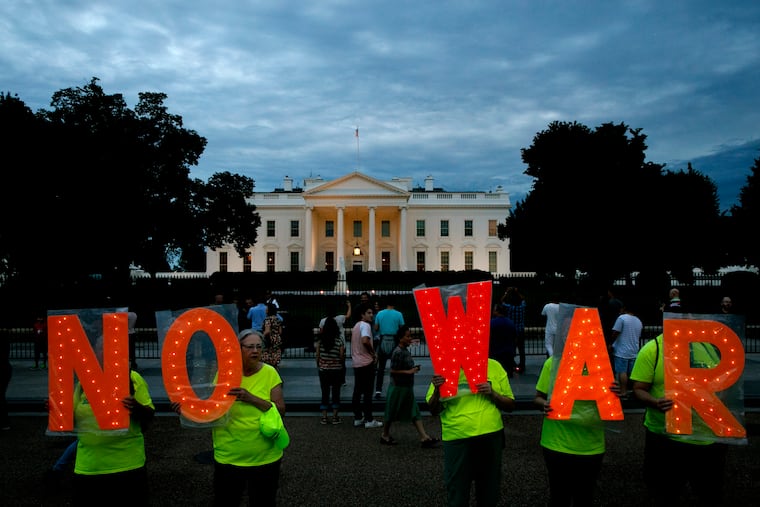Trump’s Iran stand down shows the total incoherence of his policy | Trudy Rubin
Maximum pressure on Iran with no clear goals or diplomacy will drag US into a war.

What on earth is America’s policy on Iran?
That is the operative question after President Donald Trump ordered, then called off, a U.S. strike on Iranian targets, with 10 minutes to spare.
The president tweeted that he canceled the strike — which was meant to retaliate for Iran’s downing of an unmanned U.S. drone — to avoid Iranian casualties. Why didn’t he consider that before the last minute? Probably because he famously ignores his intelligence briefings. (One shudders to think of the implications for future U.S. military action.)
More to the point, this climb-down — from a man who decries President Barack Obama for failing to abide by Syria red lines — lays bare the incoherence of Trump’s entire Iran policy. That policy has been dragging the United States toward military confrontation with Iran for months now, despite the president’s insistence that he wants out of all Mideast conflicts.
Down this road, Trump will either be sucked into a new Mideast war or revealed as a bullying bluffer. The path in between — behind-the-scenes diplomacy with Iran that might actually achieve something — is one he still refuses to take.
Consider how Trump arrived at this self-inflicted debacle.
Last May, the president made good on his campaign promise to withdraw from the Iran nuclear deal negotiated by President Obama.
Yes, that deal had flaws: It had a sunset clause and didn’t apply to missiles, and it didn’t restrain Iran’s regional aggression, but it did severely constrict Iran’s nuclear program for a decade or more.
France, Germany, and Britain, all parties to the deal, were willing to press Iran for a follow-up accord that dealt with the sunset clause and missiles. Had that effort failed, they would have joined Washington in applying new, draconian sanctions.
Instead, Trump chose to go it alone, reimposing sanctions that had been dropped as part of the nuclear bargain. The allies, who remained in the deal, were threatened with sanctions if they did business with Iran. And sanctions were recently tightened to try to prevent any Iranian exports of oil, severely hitting its economy.
Trump claimed this “maximum pressure” campaign was meant to get Iran back to the bargaining table on the nuclear deal and other issues. Yet quitting a deal that took years to negotiate hardly encouraged Tehran to join more talks.
Moreover, Secretary of State Mike Pompeo repeatedly stressed 12 demands for any negotiations that basically required Iran’s total capitulation on every issue. A nice pipe dream, but totally unrealistic.
As for national security adviser John Bolton, he made no secret of his support for regime change in Tehran. He appeared in a 2017 video telling the exiled People’s Mujahedin of Iran (MEK) opposition group in Paris that it would be in Tehran by 2019. (The MEK is despised by most Iranians because it fought with Saddam Hussein against Iran in the 1980s. So much for Bolton’s knowledge of the country.)
So here we have Trump’s team pushing for Iranian regime change or capitulation, while offering no incentive for Iran to change behavior. At the same time Trump repeatedly insists he doesn’t want a new Mideast conflict.
“Trump wants the benefits of maximum pressure but not the costs,” says the Carnegie Endowment’s Karim Sadjadpour, one of the most insightful Iran experts in Washington. “The Iranians are calling his bluff.”
Indeed, who can be surprised that Tehran undertook a calibrated reaction – crippling but not sinking two international oil tankers in the Gulf of Oman, and shooting down an unmanned U.S. surveillance drone.
What’s surprising is that the president was so unprepared for this to happen. Intelligence briefers must have tried, repeatedly, to warn him of possible Iranian reactions. The draconian sanctions campaign was bound to elicit a response from Iran, sooner rather than later.
And the risk of an unintended war didn’t end last week.
The president’s Iran strategy of all sticks, no carrots, Trump flying solo, won’t force Iran to negotiate.
““We’ll start all over and we could have a deal very quickly if they want to do it,” Trump said Saturday, adding that Iran could become America’s “best friend.” This is utter self-delusion.
More likely, Trump’s erratic behavior will tempt Iranian hard-liners to test him again. And Trump will be under greater pressure to use force, having once backed down.
“This is the danger you get into with an escalatory cycle,” says Sadjadpour. “Both sides adopt the mentality that if they don’t respond they will show weakness.”
In a normal administration, the way out of this trap would be to turn to serious, behind-the-scenes diplomacy to explore whether there is any basis for talks. “In the few instances where diplomacy worked with Iran, it worked through back channels,” adds Sadjadpour.
But Trump has rejected such diplomacy, preferring meetings with top leaders. He is more interested in summitry than substance.
With Tehran, there is zero chance of a Trump summit with Ayatollah Ali Khamenei. So unless Trump combines “maximum pressure” with serious diplomacy he is headed toward further humiliation or an unintended war.